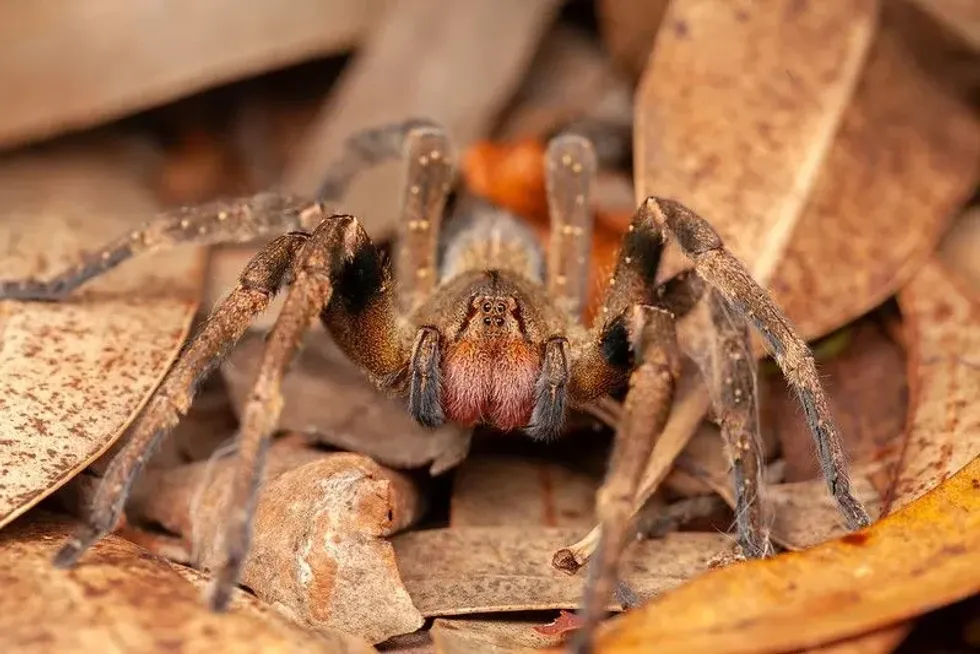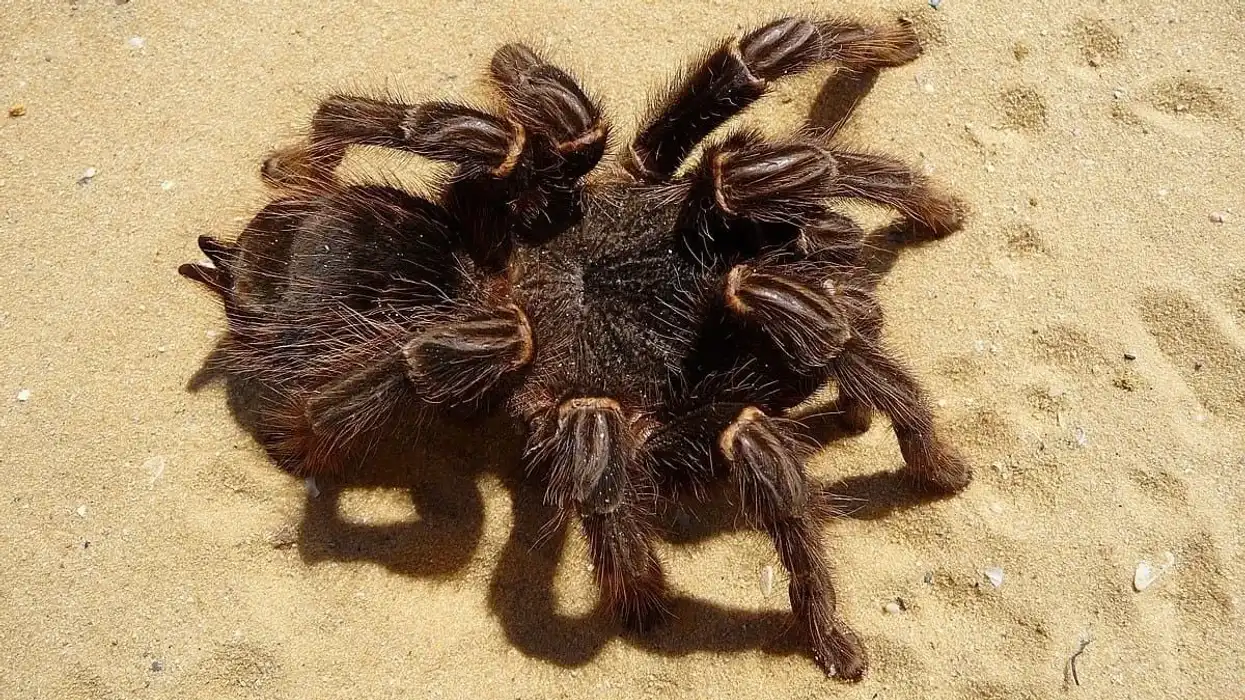The Brazilian wandering Spider, also known as the 'armed spider' and 'banana spider' is a member of the Ctenidae family. They are called wandering spiders because they wander on the floors of the jungle at night to hunt down prey instead of relying on spider webs.
They mainly reside in Colombia, Venezuela, Ecuador, Peru, Bolivia, Brazil, Costa Rica. Phoneutria nigriventer and Phoneutria fera are often present on a bunch of bananas and banana shipments, hence the name banana spiders.
In Brazil, they are known as 'aranha armadeira,' which means armed spiders. The Brazilian wandering spiders do not use web to catch prey.
Their venom contains a mixture of proteins and peptides, which act as a potent neurotoxin in mammals.
Brazilian wandering spiders are robust spiders in the Ctenidae family. They have a distinct threat display when they are near a predator and tend to hold on to the ground rather than retreating.
A Brazilian wandering spider bite can be extremely dangerous but may be treated with antivenom. Read on for more information regarding the spider often considered dubbed as the deadliest spider in the world.
Brazilian Wandering Spider Interesting Facts
What type of animal is a Brazilian wandering spider?
The Brazilian wandering spider is a venomous spider species which are different subspecies within it.
What class of animal does a Brazilian wandering spider belong to?
They belong to the class Arachnida, and their genus name is Phoneutria.
How many Brazilian wandering spiders are there in the world?
There are approximately 40,000 species of armed spiders present all over the world.
Where does a Brazilian wandering spider live?
Wandering spiders are mainly found in the northern part of South America, including Colombia, Venezuela, Ecuador, Peru, Bolivia, Brazil, Paraguay, and northern Argentina. They are present in the Amazon region, Panama and Costa Rica. They have also been introduced to Chile and Uruguay.
What is a Brazilian wandering spider's habitat?
Brazilian wandering spiders live in forested areas of the tropical and sub-tropical regions. The tropical rainforest areas are dominated by broad-leaved trees forming a dense upper canopy. These spiders are found in banana shipments and plantations. They also occupy populated agricultural areas.
Who do Brazilian wandering spiders live with?
Brazilian wandering spiders usually live in solitude and are not present in groups.
How long does a Brazilian wandering spider live?
These spiders have a lifespan of one to two years.
How do they reproduce?
The breeding season of this species of spider typically occurs in April and May. The males approach the females and subsequently fertilize them. The females lay eggs in sacs that are carried by them.
They carry up to four egg sacs containing around 3000 eggs. As the spiderlings grow, they eventually shed their exoskeleton for further growth. The spiders sexually mature following one of these molts.
What is their conservation status?
According to the Brazilian Environmental Ministry's Red list, these species are considered to be threatened. Change in climatic conditions and destruction of their habitats for human settlements are the primary concerns.
Brazilian Wandering Spider Fun Facts
What do Brazilian wandering spiders look like?
Their body is covered with blackish or grayish short hairs. They have bands of black, white, or yellow on the two pairs of legs in front. Some display bright red hairs on their venom glands. The ventral side of the abdomen contains several black dots or an overall reddish color.
How cute are they?
The deadly armed spider isn't perceived to be cute. It is recommended not to be in close proximity to the venomous spider as they are considered to be the most poisonous spider in the world, and their bites can be fatal in some cases.
How do they communicate?
These spiders, like others, use vibrations as a form of communication. They use it to attract mates, to guard territories against rivals, or to catch their food.
How big is a Brazilian wandering spider?
Their body length is from 0.67 -1.89 in, and their legs span from 5.1-7.1 in. They are almost nine times the size of fire ants.
How fast can a Brazilian wandering spider move?
These spiders do not rely on webs but hunt down their prey. They wander at night in search of food and can move quite fast.
How much does a Brazilian wandering spider weigh?
They usually weigh less than 1 oz (28 g).
What are their male and female names of the species?
Scientists do not have any distinctive names for the male and female species of these spiders. They are usually referred to simply as a male spider and a female spider.
What would you call a baby Brazilian wandering spider?
A baby Brazilian wandering spider is referred to as spiderling.
What do they eat?
They prey on a variety of insects, small amphibians, reptiles, mice, and other spiders.
Are they poisonous?
They are considered to be world's deadliest spider because their venom contains a mixture of proteins and peptides that acts as a potent neurotoxin in mammals. In the 2007 Guinness Book of World Records, they are considered the most venomous spider.
Their venom affects the central nervous system, and systemic effects include tachycardia, increased blood pressure, vertigo, fever, sweating, nausea, difficulty in breathing, and paralysis. Males produce less venom and are less lethal and deadly than females.
Among the eight species of the ctenidae family, Phoneutria fera and Phoneutria nigriventor are more dangerous. Humans who are bitten should seek medical intervention and take antivenom immediately.
Would they make a good pet?
It is recommended not to have these spiders as pets because their bite can be deadly as they are one of the most venomous spiders in the world. They should be left in the wild. It is also illegal to import these species.
Did you know...
The venom from Phoneutria nigriventer is studied by scientists, and its components have significant medicinal value. PnTx2-6 is a compound present in the venom which is perceived to be an active agent to treat certain diseases.
Can a Brazilian wandering spider kill you?
Phoneutria lives near human settlements and occasionally bites people. Its venom acts as a dangerous neurotoxin to humans containing nitric oxide, which affects the central nervous system.
The severity of the bite depends on the amount of venom passed. The signs of envenomation usually include increased heart rate, priapism, muscle tremors. Phoneutria fera and Phoneutria nigriventer are more dangerous than the rest of the species of this genus.
Symptoms appear within 10-20 minutes, and death occurs in two to six hours after the bite. There have been a few recorded cases of death due to armed spider bites; however, antivenom taken at the right time is effective in humans.
What does a Brazilian wandering spider eat?
These spiders are carnivores and hunt their prey at night. Their diet includes a range of vertebrates and invertebrates, including mice, reptiles, small amphibians, and other spiders.
Here at Kidadl, we have carefully created lots of interesting family-friendly animal facts for everyone to discover! You can even occupy yourself at home by drawing one on our Brazilian Wandering Spider coloring pages.








